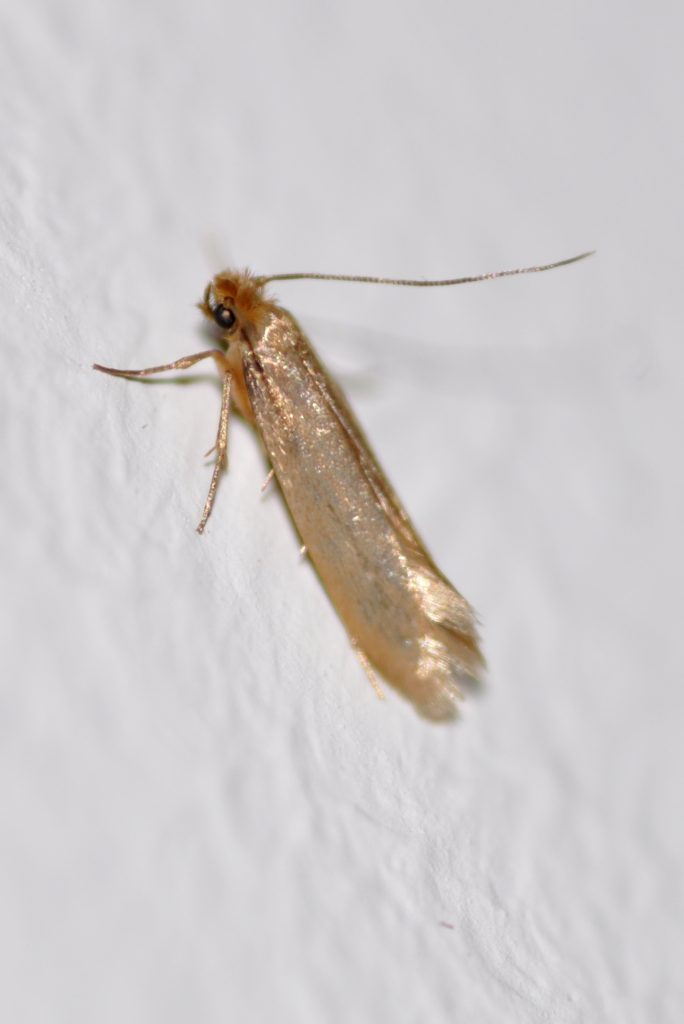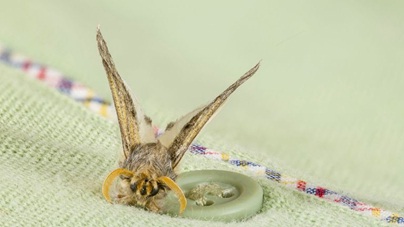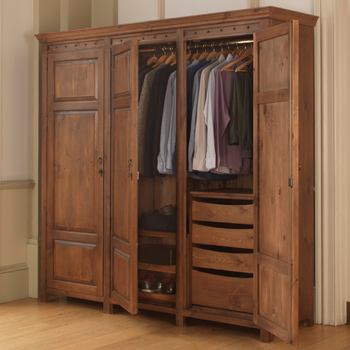Have you ever delved into your chest of drawers or wardrobe to retrieve an item of clothing only to find it completely dotted with small holes? But what is causing the damage?
Most likely the perpetrators are clothes moths, which eat fabric and leave your garments a little worse for wear.

Cloth moths are small silvery brown insects often seen in fleeting glimpses upon opening the wardrobe door.
Those pesky holes in your sweaters, scarves, and coats are a result of the adult moths laying eggs on your clothes.
It is not the actual moth that causes the damage – it is the larvae that feed on fabric that has bodily fluid on it, like sweat, saliva, oil, and even food. Their favored delicacies include wool and natural fibres such as cashmere, tweed, sheepskin, silk, fur, hair, and feathers.
Females can lay up to 100 pinhead-sized eggs over a three-week period before they die.
Clothes-munching moths more likely in warmer southern England
Flats or apartments are more susceptible to clothes moths as they have shared walls, according to the English Heritage survey.
22 April 2018, UK

Image:Warmer southern parts of England are more at risk from common clothes moths, according to the survey
Common clothes moths are more predominant in warmer parts of southern England, according to a survey.
Members of the public were asked by English Heritage to monitor moths in their homes to help the charity look after its collection of historic wool carpets, tapestries, and period clothing.
English Heritage launched Operation Clothes Moth a year ago after its experts witnessed the numbers of common or webbing clothes moths double, and observed the appearance of the pale-backed clothes moth.
Thousands of traps were handed out at English Heritage sites for the survey which collected data from 42 counties.
It discovered an “alarmingly high” number of pale-backed clothes moths and also revealed that the reported catch of the common clothes moth was significantly higher in London and the South East, where an average of 23 moths were found per trap – more than anywhere else in England.
Warning that textile moths are on the rise in Irish homes and businesses
By Eimear Dodd │26 February 2019
The company says there has been an increase in callouts
Pest control provider, Rentokil has warned textile moths are on the rise in Irish homes and businesses.
The company says there has been an increase in callouts for moth infestations of 54% since 2015. Meanwhile, callouts to deal with the butterfly-like pests have increased by almost 14% in 2018 when compared with 2017.
Dublin was the county which accounted for the most callouts for moths in 2018, with 53% of all callouts to the capital. Cork (18%), Wicklow (6%) and Kildare (5%) were the next three counties which accounted for the most callouts for moths from Rentokil.
Rapid rise of clothes moths threatens historic fabrics
By Matt McGrath ׀ Environment correspondent
- 6 April 2017
Rare furnishings and fabrics in England’s historic houses are under growing threat from an epidemic of clothes moths, say experts.
English Heritage says that moth numbers have doubled in the past five years, most likely because of warmer weather.
A new species has been found feeding happily on the ancient wool carpets and tapestries under their care.
The charity is seeking the public’s help to track the spread of the fluttering, destructive creatures.
With many historic houses and sites opening up to the public this week, conservation experts at English Heritage are concerned about the potential damage that clothes moths can wreak.
Only a handful of the 2,400 species of moths found in the UK pose a threat to clothing, upholstery, furs and even stuffed animals.
We need a solution that is effective, eco- friendly and easy to use.
The unique product Combirepel™ manufactured by C Tech Corporation is an anti-insect aversive which repels insects.
Combirepel™ works on the mechanism of repellency. It temporarily inhibits the mating cycle of the insects. The product impairs the ability of the insects to reproduce, that is the insects will not lay eggs or the laid eggs will be infertile. The product causes feeding disruption in an insect by triggering an unpleasant reaction within the insect which might try to feed on the application.
The product temporarily blocks the reproduction system of the insects by hindering the release of the vital hormones for growth.
Combirepel™ is an extremely low concern, low toxic, low hazard, non-carcinogenic and non-mutagenic insect aversive. It does not kill or cause harm to insects as well as to the environment which indirectly helps to maintain the ecological balance.

CombirepelTM wood polish additive can be mixed with the wood polish and applied on the wooden surfaces, furniture, bookshelves, wardrobes, etc.
The product available in the form of liquid concentrate can be mixed in paints in a predetermined ratio and be applied on the interior and exterior of the buildings and structures to keep the silverfish away from these places.
Our product in the lacquer form can be applied topically to the applications. The lacquer is compatible with the surfaces wood, concrete, metal, polymer, ceramic, cables, wires which are already installed, etc. The lacquer can be applied on the cupboards, shelves, wardrobes, installed wires, and cables, etc. thus protecting it from damage. The product is also effective against other pests thus protecting the trees from other pest attacks.
CombirepelTM is available in the form of the masterbatch, which can be incorporated into polymeric applications like polymeric wires and cables, pipes, etc.
CombirepelTM pest repellent spray can be sprayed on the infested area to repel the pests.
Combirepel™ is thermally stable and does not degrade on exposure to heat and sunlight. It does not kill or harm the insect but repels them. It is RoHS, RoHS2, RoHS3, REACH, APVMA, NEA, EU BPR compliant and FIFRA exempted.
Contact us at technical.marketing@ctechcorporation.com to keep the pests away.
Also, visit our websites:
http://www.ctechcorporation.com/
http://www.rodrepel.com/
http://www.termirepel.com/
http://www.combirepel.com/
Follow our Facebook pages at:
1] https://www.facebook.com/Combirepel-411710912249274/
2] https://www.facebook.com/Termirepel-104225413091251/
3] https://www.facebook.com/Rodrepel-120734974768048/
Follow us on our Twitter pages at:
1] https://twitter.com/rodrepel
2] https://twitter.com/termirepel
3] https://twitter.com/combirepel
